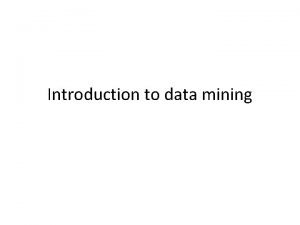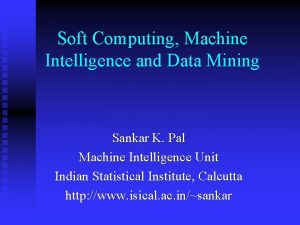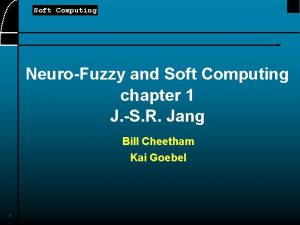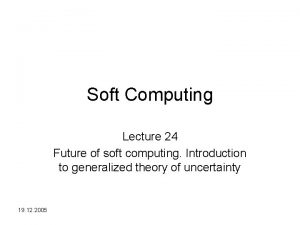Soft Computing Data Mining and Machine Learning approaches



![LITERATURE REVIEW • M. Akhil Jabbar et al [1] applied KNN and genetic algorithm LITERATURE REVIEW • M. Akhil Jabbar et al [1] applied KNN and genetic algorithm](https://slidetodoc.com/presentation_image_h/05862ab8b4fecec30088bc7334167c19/image-4.jpg)
![LITERATURE REVIEW • Rifki Wijaya et al [9] developed a smart mirror, smart chair LITERATURE REVIEW • Rifki Wijaya et al [9] developed a smart mirror, smart chair](https://slidetodoc.com/presentation_image_h/05862ab8b4fecec30088bc7334167c19/image-5.jpg)





- Slides: 10

Soft Computing, Data Mining, and Machine Learning approaches in Detection of Heart Disease: A Review By Keshav Srivastava 1

ABSTRACT Heart disease detection is the need of the hour as it not only deteriorated adults but children are also showing symptoms of it all over the world. Heart disease can occur to a person having improper diet, high cholesterol level, smoking habits, addicted to alcohol and drugs and even occurs to a diabetic patient. Various approaches are there to determine heart disease in various fields like in Machine Learning Decision Tree, Random Forest, KNN algorithms are there, in Soft Computing Multilayer Perceptron, Backpropagation Algorithms are there, in Data Mining Naïve Bayes Classifier, Logistic Regression. The aim of this paper is to provide a survey of several research papers comprising of the above techniques on determining the heart diseases. This paper gives the perspective for the researchers for future work. 2

INTRODUCTION As the name itself suggests, heart diseases occur in the heart. It can be present since birth or can occur at any age if an individual neglects his appetite or starts consuming alcohol, drugs or smoking. There are various types of heart diseases like Congenital heart disease: occurs in an individual since birth, Arrhythmia: Glitching in Heartbeat, Coronary Artery Disease: occurs due to deficiency in nutrients and oxygen in blood, Dilated Cardiomyopathy: results in weakening of muscles which results in improper supply of blood in the body. However, the above mentioned can be prevented by eating a balanced diet, exercising regularly, maintaining a good BMI, quitting smoking, reducing alcohol consumption, controlling high blood pressure and diabetes. A major challenge for the hospitals is how to provide the best treatment to the patient at an affordable cost for which computer-based information can be used by making the use of machine learning, soft computing, and data mining. 3
![LITERATURE REVIEW M Akhil Jabbar et al 1 applied KNN and genetic algorithm LITERATURE REVIEW • M. Akhil Jabbar et al [1] applied KNN and genetic algorithm](https://slidetodoc.com/presentation_image_h/05862ab8b4fecec30088bc7334167c19/image-4.jpg)
LITERATURE REVIEW • M. Akhil Jabbar et al [1] applied KNN and genetic algorithm on the breast dataset, heart dataset, liver dataset in which they improved the accuracy of the model with an accuracy of 90. 7% but the model failed to perform well for breast dataset and detecting primary tumor. • Abderrahmane Ed-daoudy et al [2] combined the power of big data and machine learning on Cleveland Heart dataset using a wearable tech which processes the real time data of the user but the model was stored on a distributed way so failure in one node will result failure in the system. • Aditi Gahave et al [4] uses BMI, height, weight, cholesterol, hemoglobin, WBC, RBC and applied multilayer perceptron and concluded that the system is efficient and economical as compared to the expensive CT scan and ECG test but if the device gives the wrong reading then this may lead to unnecessary treatment. • Sellappan Palaniappan et al [8] combines the power of soft computing, data mining and machine learning using. NET tool and concluded that the chest pain type is the most effective attribute in determining the heart disease in which neural network gives the highest accuracy of 49. 34%. 4
![LITERATURE REVIEW Rifki Wijaya et al 9 developed a smart mirror smart chair LITERATURE REVIEW • Rifki Wijaya et al [9] developed a smart mirror, smart chair](https://slidetodoc.com/presentation_image_h/05862ab8b4fecec30088bc7334167c19/image-5.jpg)
LITERATURE REVIEW • Rifki Wijaya et al [9] developed a smart mirror, smart chair and smart mouse using neural network and Arduino as hardware whose output is displayed in a smartphone. • Syed Umar Amin et al [6] took the attributes like Sex, blood pressure, age, cholesterol, diabetes, smoking habit, diet and by using data mining and genetic algorithm on MATLAB R 2012 a and achieved an accuracy of 96. 2%. • Cincy Raju et al [16] collected the data taken by the doctors and used data mining and machine learning algorithms and concluded that the SVM algorithm can determine the dependencies between the data attributes. • Chaitrali S. Dangare et al [20] uses data mining, neural network and machine learning used Weka 3. 6. 6 and attain an accuracy of 94. 44%. 5

EXIXTING WORK • A fit-bit is used to determine the heart disease in real-time using multi perceptron model which is an economical as compared to expensive ECG and CT Scan. • By combining the power of Io. T and machine learning algorithms like Naïve Bayes, K-Nearest Neighbors, Decision Tree, SVM a real-time ECG is obtained on the user’s phone. • This model utilizes the true power of machine learning algorithms as usually a dataset contains a lot of irrelevant attributes but using Logistic Regression, SVM, Naïve Bayes, ANN, Decision Tree, KNN, Random Forest the irreverent features are removed. • A huge dataset is taken on which Decision Tress and Naïve Bayes Classifier are applied and it is concluded that chest pain type is most important in determining the heart disease. 6

FUTURE WORK • Using Cloud Technologies the data can be stored on the cloud and thus can be used to determine like cancer, diabetes using machine learning, image processing, and fuzzy logic techniques. • As the data is taken in real-time so deep learning can be used to make the data more effective by updating weights and calculating error to enhance the accuracy. • A k cross validation algorithm can be implemented on the dataset to compensate for the missing values. • Other medical attributes can be used along with other data mining techniques like Clustering, Association Rules and Time Series on continuous dataset instead of categorical dataset for better performance. 7

PROPOSED ARCHITECTURE As the previous papers summary stated that we need a huge dataset which is already benchmarked by any reputed Organization or Institute, a model can predict the heart disease real efficiently. In our system a user can input the data obtained after some tests and that data will be tested with our trained data which can distinguish whether a person is suffering from any heart disease. The minimum Hardware requirement of the system are: • Core i 3 processor • 4 GB RAM • 100 GB Hard Disk The software requirements are: • Anaconda Navigator • Google Chrome • Windows 8 or above, Ubuntu 8

9

THANK YOU 10
 Mining complex types of data in data mining
Mining complex types of data in data mining Machine learning and data mining
Machine learning and data mining Data mining azure
Data mining azure Mining multimedia databases
Mining multimedia databases Difference between strip mining and open pit mining
Difference between strip mining and open pit mining Difference between text mining and web mining
Difference between text mining and web mining What is data mining and data warehousing
What is data mining and data warehousing Crm data warehouse models
Crm data warehouse models Olap in data mining
Olap in data mining Introduction to data warehouse
Introduction to data warehouse Unsupervised learning in data mining
Unsupervised learning in data mining



















